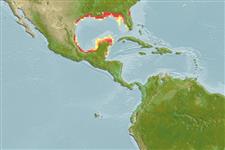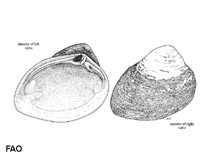Rangia cuneata (Sowerby I, 1831)
Atlantic rangia| Native range | All suitable habitat | Point map | Year 2050 |

|
| This map was computer-generated and has not yet been reviewed. |
| Rangia cuneata AquaMaps Data sources: GBIF OBIS |
Classification / Names Common names | Synonyms | CoL | ITIS | WoRMS
Bivalvia | Venerida | Mactridae
Environment: milieu / climate zone / depth range / distribution range Ecology
Benthic; brackish; depth range 0 - 124 m (Ref. 104339), usually 0 - 2 m (Ref. 104339). Tropical; ? - 15°C (Ref. 104336); 31°N - 17°N, 98°W - 81°W
Distribution Countries | FAO areas | Ecosystems | Occurrences | Introductions
Western Atlantic: The Gulf of Mexico from Campeche to northwest Florida. Introduced to the Atlantic coast of North America (east coast of Florida to Chesapeake Bay and to the Hudson River). Northeast Atlantic: Introduced in Belgium and Poland. Tropical to temperate.
Length at first maturity / Size / Weight / Age
Maturity: Lm ?, range 1 - ? cm Max length : 9.4 cm SHL male/unsexed; (Ref. 104339); max. reported age: 15 years (Ref. 104339)
Short description Morphology
Shell oval, heavy, very thick. Hinge with lateral teeth transversally striated. Pallial sinus reduced. Umbones anterior, pointing inward and in anterior direction. Periostracum strong and smooth. Colour: externally dirt white, internally glossy white with slight blue-grey tinge; periostracum grey-brown (Ref. 271).
Maximum depth range from Ref. 104365. Lives in low salinity waters, found predominantly in estuaries (Ref. 121904). Also in salt marsh (Ref. 104365). Subtidal (Ref. 104487). It is found infaunal in sandy mud, in very low salinity brackish water (Ref. 271). Habitats have high water turbidity. Found in soft substrates which are a mixture of sand, mud and vegetation (Refs. 104240, 104487). A non-selective filter-feeder which turns substantial quantities of plant detritus and phytoplankton into clam biomass. Also obtains nutrition from sediments via direct ingestion or by feeding on bacteria. Predators include fish, crabs, gastropods and ducks (Ref. 104240).
Life cycle and mating behavior Maturity | Reproduction | Spawning | Eggs | Fecundity | Larvae
Life cycle: Embryos develop into free-swimming trocophore larvae, succeeded by the bivalve veliger, resembling a miniature clam (Ref. 833). Spawning is continuous throughout the year (Ref. 104339).
Main reference
References | Coordinator | Collaborators
Carpenter, K.E. (ed.). 2002. (Ref. 271)
IUCN Red List Status (Ref. 130435)
CITES status (Ref. 108899)
Not Evaluated
CMS (Ref. 116361)
Not Evaluated
Threat to humans
Human uses
Fisheries: commercial
| FishSource | Sea Around Us
Tools
More information
Internet sources
BHL | BOLD Systems | CISTI | DiscoverLife | FAO(Publication : search) | Fishipedia | GenBank (genome, nucleotide) | GloBI | 1 GoMexSI (interaction data) | Google Books | Google Scholar | Google | PubMed | Tree of Life | Wikipedia (Go, Search) | Zoological Record
Estimates based on models
Preferred temperature
(Ref. 115969): 23.2 - 25.1, mean 23.9 (based on 121 cells).
Resilience
(Ref. 69278):
Very Low, minimum population doubling time more than 14 years (K=0.01-0.03; tmax=15).



